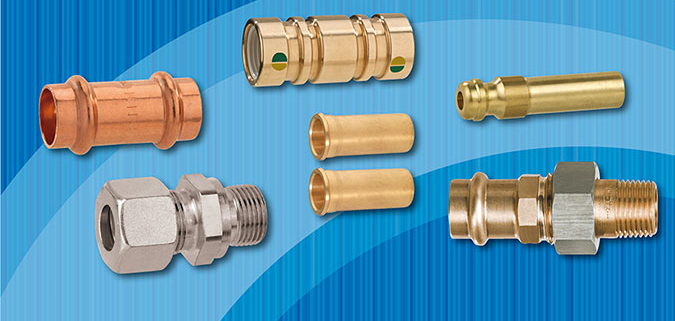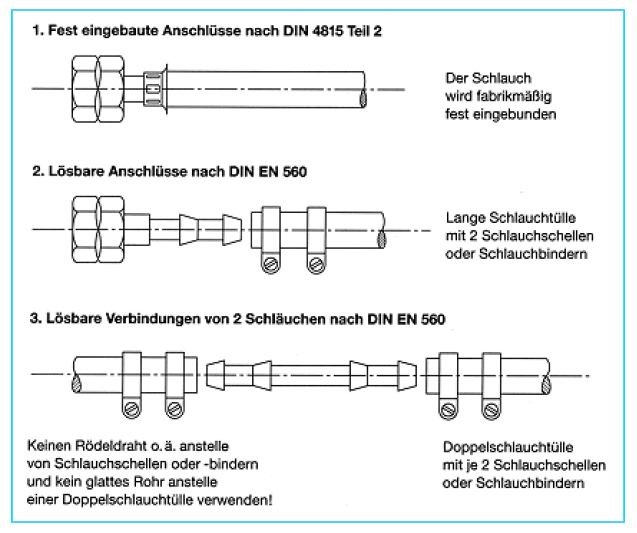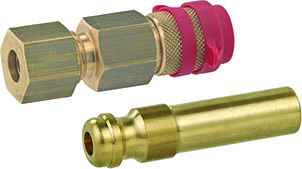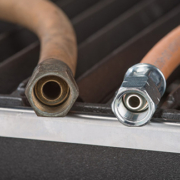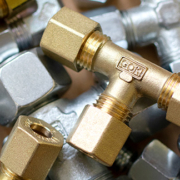Which connections and adapters can you find in an LPG system?
The construction of LPG systems can be relatively simple, for example for small cylinder systems; however, it can also be very complex and multi-layered as for heating systems for large-scale building complexes. As LPG is also used in many different fields of application, there is a large number of connection and adapter options available.
When it comes to the connections between the LPG tank or cylinder and the pressure regulator, there is an impressive choice. We have compiled a datasheet that displays the most important connections for pressure regulators:Inlet connectors.
The number of outlet connections at the GOK pressure regulators is also impressively high. Here is the associated list: Output connectors.
Variably usable compression fittings
Although the majority of the connections are already mentioned in the two datasheets, we still want to look at the most important and most common ones a bit more closely. The compression fitting not only connects pipe pieces to each other, but can also serve as an inlet or outlet connector on the pressure regulator. The following versions are possible, among others:
- Straight compression fitting, angled, T- and cross screw connections (connecting two or more pipes with the same dimensions)
- Reducing compression fitting (connecting two or more pipe pieces of different dimensions)
- Screw-in compression fitting (coupling nut and olive on one side; screwed plug in imperial dimension on the other)
- Screw-on compression fitting (coupling nut and olive on one side; inner pipe thread on the other)
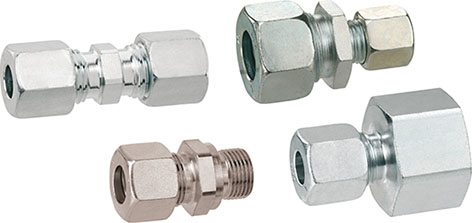
Straight compression fitting, reducing compression fitting, screw-in and screw-on compression fitting (from top left to bottom right)
Some screw compression fittings are available with a pipe socket on one side, so nothing other than a short piece of piping. In addition, there are short pipe pieces on which the nut and olive are pre-assembled.
“Half” compression fitting
An increasingly used type of connection between fittings and pressure regulators is the separating screw connection – either the solder/separation connector (LTV) or the compression/separation connector (PTV). For this purpose, there are adapters for pressing (Viega Profipress G) or for brazing copper pipe. Some fittings and pressure regulators have a “half” compression fitting, which means: Here, the connection ends with a 3/4 inch nut. This makes it easy for you to replace the pressure regulator without having to put your hand on the line.
Another important connection type is the ball-cone connector (for example: 1/4 LH M). The connection can be found especially frequently as an outlet connector for cylinder pressure regulators. The fitting for the male thread on the pressure regulator is an appropriate connection, for example G 1/4 LH nut with internal taper and coupling nut, which is often found on a hose assembly. One side of the hose assembly is fixed to the pressure regulator by means of a coupling nut; the other creates the connection to the consumer equipment or the line. All ball-cone connections with 1/4, 3/8 and 1/2 in LPG systems have a left-hand thread.
For special connections or for those authorised to integrate hose assemblies themselves, there is the connection shape of the hose nozzle. Please note, however, that private users are not allowed to produce hose assemblies for LPG systems themselves.
Generally, the use of permanently integrated hose assemblies is required in Germany (see diagram). Exceptions exist, for example, for use in the laboratory or in metal businesses according to DIN EN 560.
Secure plug-in connection
At the end of hose assemblies or, for example, with coupling valves, you can find a plug-in fitting. In combination with the suitable adapter, the quick coupler, this results in a secure connection that can be loosened quickly and without great effort – unlike compression fittings.
If you choose a plastic connection system, you can use the Geopress coupling and transition kits – also for plastic lines laid underground. Last but not least: Of course, there is also a large number of metric and imperial male and female threads for LPG systems. More on this in these information documents:
The type of connection that you can use and where is governed by the applicable technical rules.Please be aware of these before designing or modifying a system.
